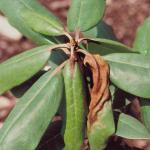Phytophthora Dieback
Several species of the Phytophthora fungus cause Phytophthora dieback.
Host Plants
Phytophthora dieback most commonly affects rhododendron and azalea (Rhododendron) species as well as Japanese andromeda (Pieris japonica).
Description
Initial infections result in the formation of dark green spots/blotches at the base of buds or in leaf axils where water collects. Within a day or two, the infected spots/blotches turns brown. Early patterns of dieback typically move from the base of the buds to the tip of the shoot or down succulent shoots to petioles and outward to the base of the leaf blade. However, if water collects at the leaf margin, lesions can begin there and progress inward toward the main vein.
Phytophthora dieback may kill young plants with extensive succulent growth, while blighting only the new growth on older plants with woody stems.
Disease Cycle
Generally, in New England landscapes the Phytophthora species that cause dieback find the growing conditions and winters unfavorable for survival. Phytophthora dieback inoculum readily stays alive within infected plant debris that remains wet throughout the winter, and where temperatures do not drop very far below 32o F. New transplants infected with Phytophthora, as well as puddles of water that include infected plant debris function as sources of spores that splash onto young leaves and green shoot tips in the spring. Phytophthora dieback infections begin on plants when spring weather warms, and there is a film of water on young leaves, green shots or buds. These provide optimal conditions for spore germination and penetration of the tissues. Once the plant is infected, the fungus produces new spores in lesions that remain wet overnight. Then rain and irrigation splash spread spores to infect nearby wet, succulent growth.
Management Strategies
Use a combination of cultural measures, plant resistance, and fungicide controls to manage Phytophthora dieback. Moist, well-drained sites are required for Rhododendron or Pieris to thrive, as well as to avoid problems with Phytophthora dieback. Several inches of composted bark mulch or a ground cover that prevents puddling during irrigation and rainstorms reduces splash dispersal of inoculum onto foliage and shoot tips. If overhead irrigation is used, apply it early enough in the day that the foliage dries before sunset. Monitor sites regularly and promptly remove affected blanches as well as entire plants that are severely infected. If Phytophthora dieback is a persistent problem, replace diseased plants with resistant cultivars or other plants better adapted to the site. When there is a history of Phytophthora dieback and weather conditions favor infection, protect high value plants with fungicides specifically labeled to control Phytophthora species. Repeat applications per label directions as long as wet conditions prevail.
Written by: Dan Gillman
Revised: 09/2011
Photos: R. G. Linderman, Diseases of Woody Ornamentals and Trees. APS Press.

